Water fountains are beautiful features, but they’re made even better by adding fish. However, it’s important that you don’t introduce the wrong breed into the water, or you’ll end up causing a host of problems. You also have to consider the maintenance treatment that you use, so you don’t create algae.
You can add fish to a water fountain if there’s enough room for them to swim, you use the right chemicals to keep the water clean, and the fish are the right breed. Goldfish, Koi fish, catfish, and mosquito fish are all excellent choices to live and thrive in a water fountain.
Throughout this article, you’ll also learn the following info about adding fish to a water fountain:
- Details about the aforementioned fish in the intro
- Various recommendations to keep the fish safe and healthy
- Specifications for the size of the fountain and its pump
What Types of Fish Can Live in a Water Fountain?
It’s important that you choose fish that can thrive in an outdoor (or indoor) water fountain. Many fish are able to live, but a lot of them have trouble staying alive without getting harmed. Instead of choosing the fish randomly, you’ll be able to pick from a list so you know they’ll be happy throughout their lives.
Here’s a list of four fish that can live in a water fountain:
- According to Serenity Health, goldfish are some of the most popular fountain fish. Goldfish come in a variety of sizes, some of which are perfectly fit for water fountains. They’re not afraid of confined spaces, nor do they need a plethora of requirements to stay entertained or alive in the environment.
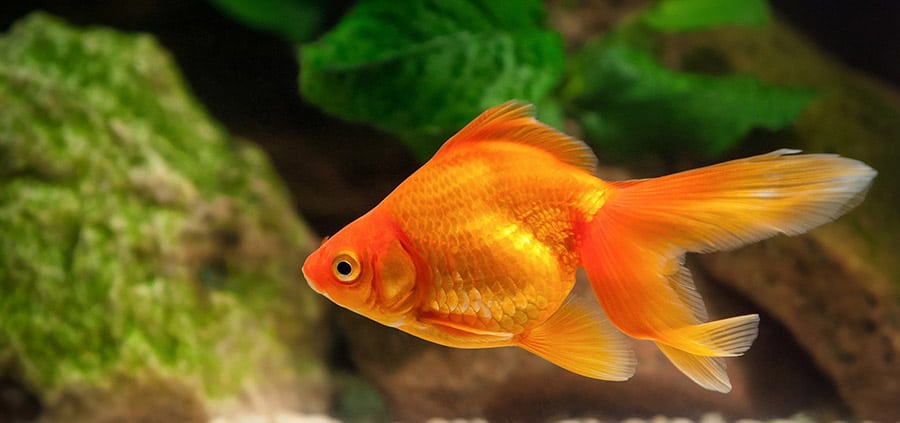
- Koi fish are also commonly found in water fountains. While they’re typically known for being a high-quality, expensive fish, Koi fish can be found in ponds and water fountains in residential areas. They come in a wide price range, so there’s no need to cross them off of your list just yet.
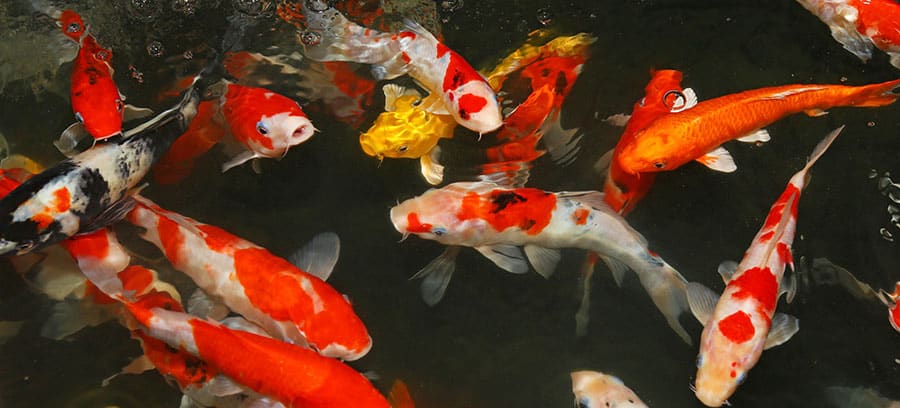
- Adding mosquito fish will keep the local bug population at a minimum. They’re not the most popular fish, but they’re excellent when it comes to pest control. They get their name from the fact that they eat mosquitos and their larvae, making them a top choice for large water fountains.
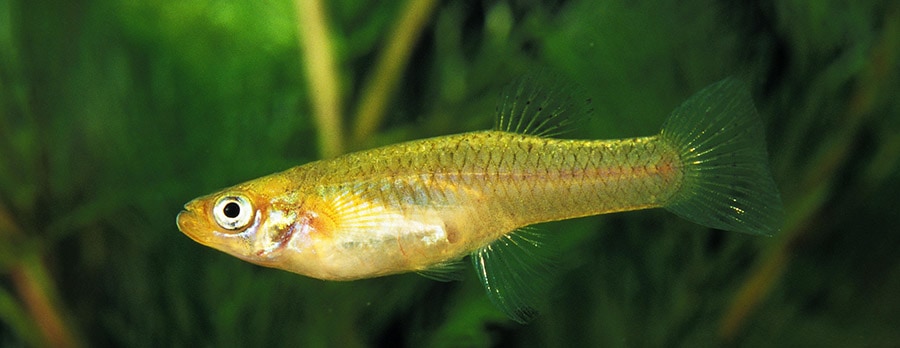
- Catfish will prevent muck from building up on the bottom of the water fountain. They’re known to be bottom feeders, which is why many people prefer to use them in outdoor bodies of water. Waste from other fish, debris from dead plants, and algae are all consumed by catfish.
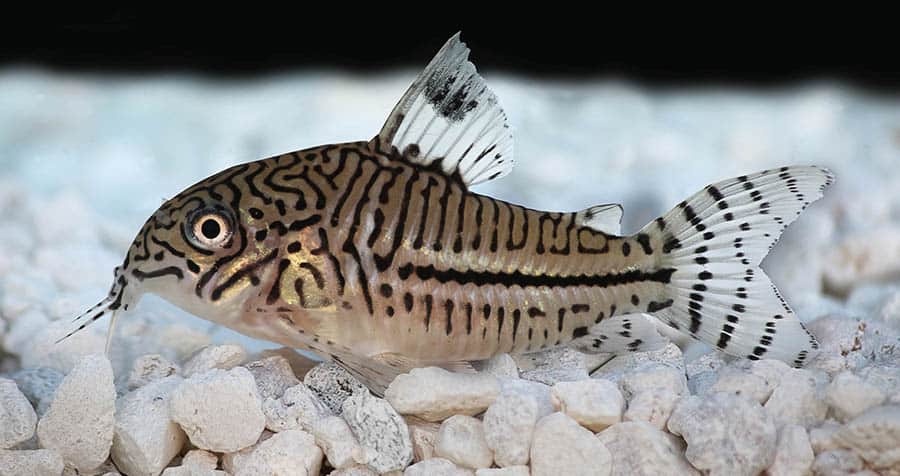
Ensuring that you choose these four fish to live in your water fountain will keep it looking beautiful and clean. They all serve their part in the ecosystem and none of them feel too crowded or endangered.
If you want to know more about fountain dimensions, read on.
How Big Should the Fountain Be?
Now that you know the fish that can live in your water fountain, it’s time to explore the dimension recommendations. When your water fountain is too shallow or narrow, they won’t be able to move around enough. Imagine being stuck in a small cage without any depth! It’s a nightmare, so make sure you’re providing the proper fountain size.
Keep the fountain at least 12 to 24 inches deep
Your fish need enough space to move freely without feeling liek they’re stuck in the same spot. 12 to 24 inches of depth is enough to keep your fish entertained, but you can go deeper than that if you’d like. Some in-ground fountains can be well over five feet deep, so it’s all up to your personal preferences.
Make sure they have swimming space
Much like the depth, the width and length need to be a decent size. Many water fountains are circular, in which case you should aim for a minimum of six feet across. Needless to say, anything more than six feet is welcome. The bigger the fountain, the more room your fish will have to move around and feel good.
In-ground fountains need to have blockades
If your fountain is flush with the ground, then you’ll need a small gate to prevent your fish from popping out. Some fish love to jump around and splash, but it’s also a matter of safety for your guests. Anyone walking near an in-ground fountain is at risk of falling in, so make sure you have a decent gate or raised ledge to prevent a disaster.
Knowing these dimensions and suggestions will allow your fish to feel comfortable. It’ll also protect them from unwanted harm. The good news is that most water fountains designed for fish already come with these requirements. However, you can prepare the fountain for your fish to enhance their experience before they move in.
How to Prepare a Water Fountain for Fish
When you get the fish for your water fountain, the last thing you want to do is toss them in there without preparing the water. You need to make sure that it’s free of toxic chemicals, including chlorine that’s naturally found in tap water. There are several different preparation tactics to ensure that the fountain is ready to go beforehand.
Follow these suggestions to keep your fish safe:
- Sortra claims that the water temperature needs to be between 65 to 75 degrees Fahrenheit before you introduce fish to the fountain. Anything too cold can freeze the fish or slow them down, causing extreme discomfort. Temperatures over 75 to 80 degrees will overheat the fish and result in sicknesses.
- Remove chlorine from the water so you don’t harm the fish. There are plenty of products on that market for getting rid of chlorine. It occurs in tap water, including that which comes out of your garden hose. Even if you use well water, consider using chlorine removal chemicals to prevent your fish from being harmed.
- Get the right kind of food before you get the fish. It’s important that your fish are eating a healthy diet that keeps them energetic throughout the day. Consult a veterinarian before you purchase fish food. Also, check if it’ll harm other fish and plants in the fountain.
- Make sure you have a heater for your water fountain. If it’s too cold, your water fountain will have all sorts of issues. Not only is it bad for the water to be frozen for the equipment, but it can harm the plants and fish in the tank. The heater can maintain the aforementioned temperature range between 65 to 75 degrees.
Your fish will be thankful that you took the time to get the fountain ready for their arrival. Instead of pouring hose water and getting the food later, you’ll be glad you got everything ready.
With chemicals and cleanliness comes equipment. The next section will cover the different equipment that you’ll need to get for your water fountain.
What Size Pump Should You Get?
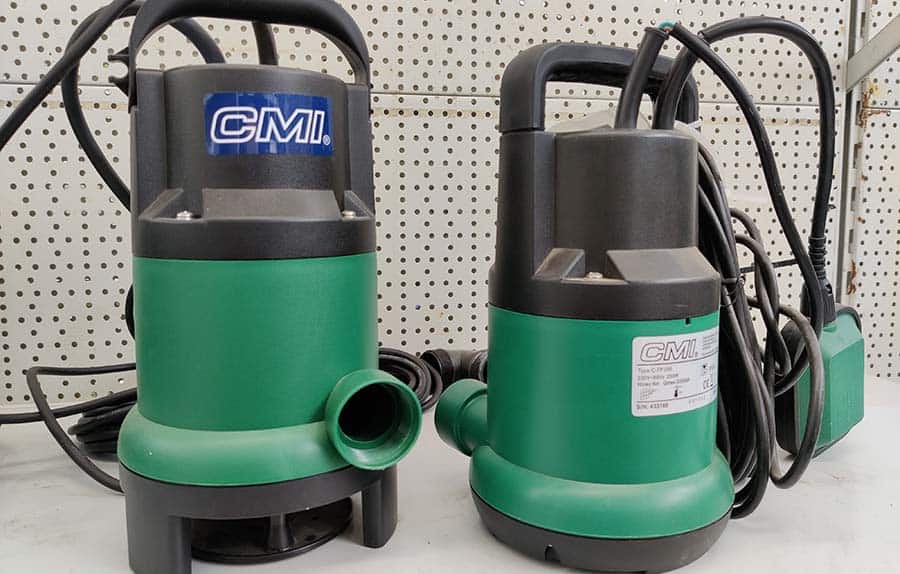
Water fountains are known for the structure, sparkling water, and fish, but the equipment is equally important. The size of your pump will determine how quickly the water flows, but it also keeps your fountain’s water clear over the years. The pump should be between 0.25 to 1.5 horsepower, depending on the size and shape of the pond.
Try these suggestions when you’re getting equipment for your water fountain:
Get a heater if your water fountain gets cold
As you hopefully read in the previous section, heaters can play a huge role in the well-being of your fountain’s inhabitants. Harsh winters can prove tremendously difficult to deal with when you have plants and fish in the fountain. Fortunately, small heaters don’t cost much and the monthly electric or gas bill won’t go up much either.
Install a variable speed pump to save energy
Variable speed pumps, also known as VSPs, are designed to reduce the energy cost of your pump. They range from low to high horsepower and RPMs, allowing you to control how fast the water flows. Many experts recommend that you keep a variable speed pump on at all times of the day at a low setting, so the water’s always moving.
Purchase a water filter to clear the fountain
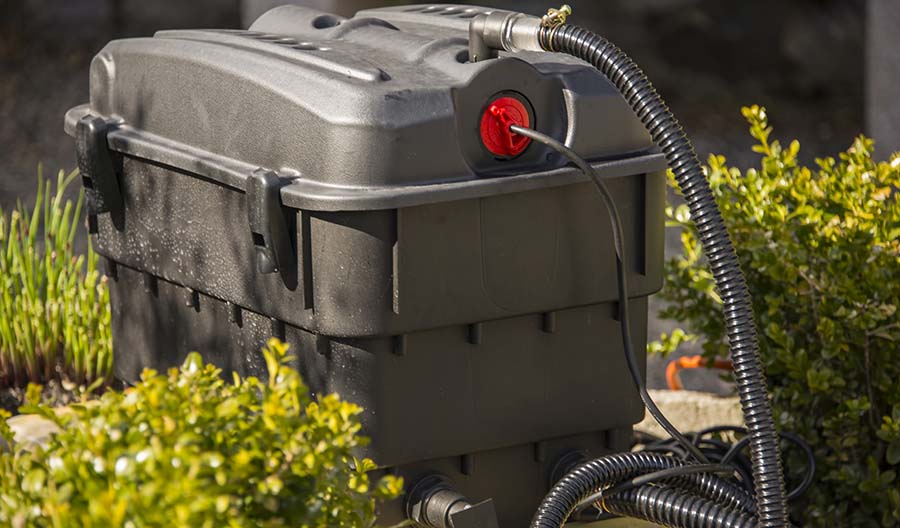
Hook up a water filter to the pump and heater setup. You’ll be able to choose between sand, diatomaceous earth, or traditional cartridge filters. All of these options are worthwhile, especially if there’s a lot of algae growing in the water fountain. Water filters are inexpensive and can be cleaned often for optimal results.
Getting the proper equipment for your water fountain will save you time, money, and frustration in the long run. Rather than having to manually clean it every day or worry about the water freezing, you’ll be good to go.
Equipment is just a fraction of the upkeep required for a fish-filled water fountain. There are many other maintenance issues that need to be addressed, all of which will be covered below.
Other helpful articles: Do Water Fountains Use a Lot of Electricity?
Maintenance Tips and Tricks
Keeping your water fountain clean looks good and allows your fish to see clearly. It also prevents diseases from spreading and bugs from gathering. As long as you follow these suggestions, your fountain will look crystal-clear and the fish will love it.
- Sunnydaze explains that you can clean your water fountain with a sponge. Instead of using a bunch of harmful chemicals, a big sponge will do the trick. Don’t put anything on it, especially soap! A dry sponge can scrub algae off the walls, allowing it to flow into the filter and remove itself.
- Run the pump and filter for a few hours each day (bare minimum). Your fish need a clean environment, and your pump and filter are the key components to let it happen. Running the pump for a few hours will remove contaminants from the water. The more you run it, the clearer the water will be.
- Get catfish to clean the water fountain for you. Catfish love to eat everything that causes cloudiness in your water fountain. They’re known to eat all of the algae and droppings, so why not save yourself the time and effort by getting a few of them? You’ll love the cleanliness!
- Stay away from low-quality water dye. It’s not recommended that you use any type of dye or coloring to change the appearance of your water fountain when you have fish. However, if you’re adamant about using them, making sure that they’re not oil-based or low-quality; Otherwise, it’ll cause stains, corrosion, and illnesses among your fish.
- Clean the filter and pump basket weekly (or as needed). Installing a pump and filter isn’t the final solution for water clarity. Make sure that you’re cleaning the pump and filter as needed. They’re not an unbeatable solution, but rather a way to gather all of the contaminants in a simple, easy-to-access area.
Water fountains can look wonderful or horrific; The difference lies in your maintenance methods. This collection of five tips is more than enough to promote a thriving ecosystem that doesn’t smell like a river or look like mud!
Can You Add Water Features to the Fountain?
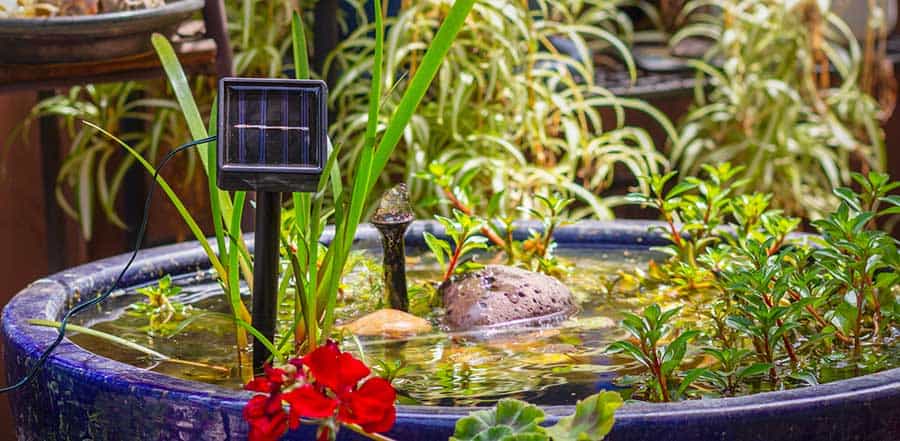
We’ve covered the preparation and maintenance processes, so it’s time to get into the fun details. Water fountains with fish are always an entertaining setup, but they’re made even better by adding lights, rocks, and other features.
Are you ready to find out how you can spice up your fountain? Here’s a handful of options:
- Consider adding built-in lights to keep the fountain bright. If you want to enhance the appearance of your water fountain, then adding a bit of color is a fantastic selection. Getting built-in lights installed in your water fountain isn’t too expensive, but try to get it done before you have the fountain built.
- Floating lights are an option if you want a portable solution. These light systems won’t harm the fish if they’re small enough. They can float around and change the color or boost brightness throughout the fountain. Another benefit of having floating lights is that they’re much cheaper than built-in lights.
- Mini built-in fountains are a fun possibility. You can have a system of small fountains or bubblers spread throughout your fountain. Much like the built-in light recommendation, it’s a good idea to have these features installed before the water fountain is filled with water, plants, and fish.
- Add stylish rocks and plants. Rocks aren’t the first thing that comes to mind when you’re putting fish in a water fountain, but they serve a purpose: To give your fish a place to hide and feel protected. Plants also serve as excellent hideaways, and they boost the water by adding a food source.
Note: Some water features can be dangerous for the fish in the fountain, including excessively strong jets, lights that produce too much heat, and jagged wrongs. Also, make sure that the algae and plants in the water fountain aren’t toxic or harmful to the different species of fish in the area.
Other helpful articles: Do Solar Water Features Need Electricity?
FAQ
How long will fish live in a water fountain?
As long as you take care of the fountain with the steps from this article, your fish will live their full lifespan.
How big can they grow?
Fish grow to the size of their tank, but many estimates state that Koi fish, a popular fountain fish, can grow up to 26 inches long.
What do fish eat in a fountain?
Fish living in a water fountain require the same food that they do out of it. Check with a local expert to ensure that the food has enough vital nutrients for your fish.
Conclusion
You can add fish to a water fountain, but it’s important to make sure that they’re happy and healthy throughout the process. Never put large fish in a small fountain because they’ll feel cramped and anxious. The good news is that you know everything there is to know about raising fish in a water fountain.
Here’s a quick recap of the post:
- Goldfish, mosquito fish, catfish, and Japanese Koi fish are the most common fish for water fountains.
- Consider getting pumps, filters, and heaters to keep the fountain clean and clear for the fish.
- Keep the water fountain maintained with chlorine removal solutions and a sponge for scrubbing.
- Make sure that the fountain is wide, long, and deep enough to have fish swim around.
- You can add water features to a fountain with fish, but they can’t be invasive or alter the environment.

